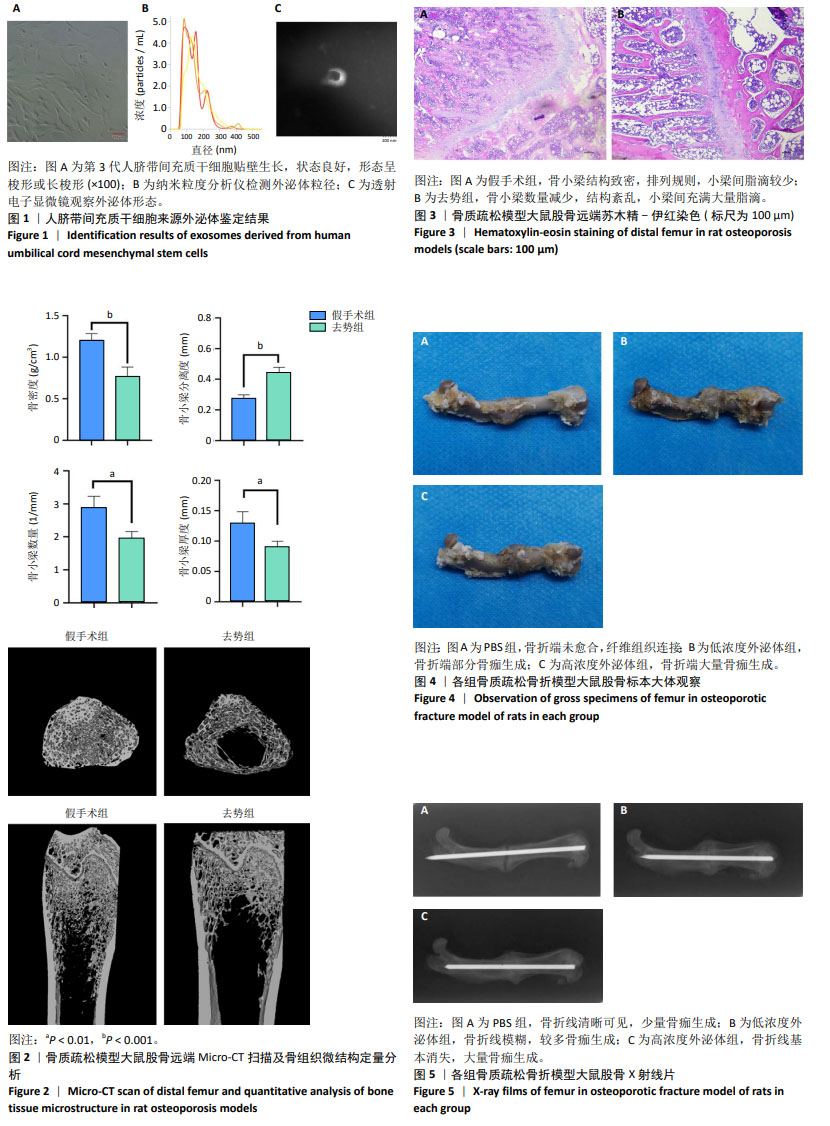[1] HE X, WANG Y, LIU Z, et al. Osteoporosis treatment using stem cell-derived exosomes: a systematic review and meta-analysis of preclinical studies. Stem Cell Res Ther. 2023;14(1):72.
[2] 中华医学会骨质疏松和骨矿盐疾病分会.中国骨质疏松症流行病学调查及“健康骨骼”专项行动结果发布[J].中华骨质疏松和骨矿盐疾病杂志,2019,12(4):317-318.
[3] TAŃSKI W, KOSIOROWSKA J, SZYMAŃSKA-CHABOWSKA A. Osteoporosis - risk factors, pharmaceutical and non-pharmaceutical treatment. Eur Rev Med Pharmacol Sci. 2021;25(9):3557-3566.
[4] NOH JY, YANG Y, JUNG H. Molecular Mechanisms and Emerging Therapeutics for Osteoporosis. Int J Mol Sci. 2020;21(20):7623.
[5] LU CH, CHEN YA, KE CC, et al. Mesenchymal Stem Cell-Derived Extracellular Vesicle: A Promising Alternative Therapy for Osteoporosis. Int J Mol Sci. 2021;22(23):12750.
[6] WANG X, LI X, LI J, et al. Mechanical loading stimulates bone angiogenesis through enhancing type H vessel formation and downregulating exosomal miR-214-3p from bone marrow-derived mesenchymal stem cells. FASEB J. 2021;35(1):e21150.
[7] FILIPOWSKA J, TOMASZEWSKI KA, NIEDŹWIEDZKI Ł, et al. The role of vasculature in bone development, regeneration and proper systemic functioning. Angiogenesis. 2017;20(3):291-302.
[8] HULDANI H, ABDALKAREEM JASIM S, OLEGOVICH BOKOV D, et al. Application of extracellular vesicles derived from mesenchymal stem cells as potential therapeutic tools in autoimmune and rheumatic diseases. Int Immunopharmacol. 2022;106:108634.
[9] 陈三,杨润泽,吴家媛.预处理来源外泌体在细胞增殖分化及凋亡中的作用[J].中国组织工程研究,2023,27(19):3029-3039.
[10] BEI HP, HUNG PM, YEUNG HL, et al. Bone-a-Petite: Engineering Exosomes towards Bone, Osteochondral, and Cartilage Repair. Small. 2021;17(50):e2101741.
[11] MA Z, WANG Y, LI H. Applications of extracellular vesicles in tissue regeneration. Biomicrofluidics. 2020;14(1):011501.
[12] CONSTÂNCIO C, PAGANI BT, AZEVEDO RMG, et al. Effect of ovariectomy in bone structure of mandibular condyle. Acta Cir Bras. 2017;32(10):843-852.
[13] 佘昶,董启榕,周晓中.大鼠股骨开放截骨模型与闭合骨折模型制作的比较[J].中国组织工程研究与临床康复,2008,12(46): 9071-9075.
[14] 李风波,孙晓雷,马剑雄,等.柚皮苷对去势大鼠骨质疏松性骨折愈合的作用[J].中华创伤杂志,2015,31(4):370-375.
[15] SHI H, JIANG X, XU C, et al. MicroRNAs in Serum Exosomes as Circulating Biomarkers for Postmenopausal Osteoporosis. Front Endocrinol (Lausanne). 2022;13:819056.
[16] SUN Y, ZHANG HJ, CHEN R, et al. 16S rDNA analysis of osteoporotic rats treated with osteoking. J Med Microbiol. 2022;71(6). doi: 10.1099/jmm.0.001552.
[17] KJÆR N, STABEL S, MIDTTUN M. Anti-osteoporotic treatment after hip fracture remains alarmingly low. Dan Med J. 2022;69(10): A01220010.
[18] WU XY, LI HL, SHEN Y, et al. Effect of Body Surface Area on Severe Osteoporotic Fractures: A Study of Osteoporosis in Changsha China. Front Endocrinol (Lausanne). 2022;13:927344.
[19] RUDIANSYAH M, EL-SEHRAWY AA, AHMAD I, et al. Osteoporosis treatment by mesenchymal stromal/stem cells and their exosomes: Emphasis on signaling pathways and mechanisms. Life Sci. 2022;306: 120717.
[20] GUO J, TIAN S, WANG Z, et al. Hydrogen saline water accelerates fracture healing by suppressing autophagy in ovariectomized rats. Front Endocrinol (Lausanne). 2022;13:962303.
[21] SUZUKI T, NAKAMURA Y, KATO H. Vitamin D and Calcium Addition during Denosumab Therapy over a Period of Four Years Significantly Improves Lumbar Bone Mineral Density in Japanese Osteoporosis Patients. Nutrients. 2018;10(3):272.
[22] BRENNAN MÁ, LAYROLLE P, MOONEY DJ. Biomaterials functionalized with MSC secreted extracellular vesicles and soluble factors for tissue regeneration. Adv Funct Mater. 2020;30(37):1909125.
[23] WEISS ML, ANDERSON C, MEDICETTY S, et al. Immune properties of human umbilical cord Wharton’s jelly-derived cells. Stem Cells. 2008;26(11):2865-2874.
[24] LI T, XIA M, GAO Y, et al. Human umbilical cord mesenchymal stem cells: an overview of their potential in cell-based therapy. Expert Opin Biol Ther. 2015;15(9):1293-1306.
[25] WIDJAJA G, JALIL AT, BUDI HS, et al. Mesenchymal stromal/stem cells and their exosomes application in the treatment of intervertebral disc disease: A promising frontier. Int Immunopharmacol. 2022;105:108537.
[26] CAO JY, WANG B, TANG TT, et al. Exosomal miR-125b-5p deriving from mesenchymal stem cells promotes tubular repair by suppression of p53 in ischemic acute kidney injury. Theranostics. 2021;11(11):5248-5266.
[27] YAGHOUBI Y, MOVASSAGHPOUR A, ZAMANI M, et al. Human umbilical cord mesenchymal stem cells derived-exosomes in diseases treatment. Life Sci. 2019;233:116733.
[28] YANG BC, KUANG MJ, KANG JY, et al. Human umbilical cord mesenchymal stem cell-derived exosomes act via the miR-1263/Mob1/Hippo signaling pathway to prevent apoptosis in disuse osteoporosis. Biochem Biophys Res Commun. 2020;524(4):883-889.
[29] KURYWCHAK P, TAVORMINA J, KALLURI R. The emerging roles of exosomes in the modulation of immune responses in cancer. Genome Med. 2018;10(1):23.
[30] KALLURI R, LEBLEU VS. The biology, function, and biomedical applications of exosomes. Science. 2020;367(6478):eaau6977.
[31] WANG L, WANG J, ZHOU X, et al. A New Self-Healing Hydrogel Containing hucMSC-Derived Exosomes Promotes Bone Regeneration. Front Bioeng Biotechnol. 2020;8:564731.
[32] YOUSSEF EL BARADIE KB, HAMRICK MW. Therapeutic application of extracellular vesicles for musculoskeletal repair & regeneration. Connect Tissue Res. 2021;62(1):99-114.
[33] HU Y, ZHANG Y, NI CY, et al. Human umbilical cord mesenchymal stromal cells-derived extracellular vesicles exert potent bone protective effects by CLEC11A-mediated regulation of bone metabolism. Theranostics. 2020;10(5):2293-2308.
[34] LEE KS, LEE J, KIM HK, et al. Extracellular vesicles from adipose tissue-derived stem cells alleviate osteoporosis through osteoprotegerin and miR-21-5p. J Extracell Vesicles. 2021;10(12):e12152.
[35] FAN J, LEE CS, KIM S, et al. Generation of Small RNA-Modulated Exosome Mimetics for Bone Regeneration. ACS Nano. 2020;14(9): 11973-11984.
[36] ZHANG Y, HAO Z, WANG P, et al. Exosomes from human umbilical cord mesenchymal stem cells enhance fracture healing through HIF-1α-mediated promotion of angiogenesis in a rat model of stabilized fracture. Cell Prolif. 2019;52(2):e12570.
[37] FANG S, LIU Z, WU S, et al. Pro-angiognetic and pro-osteogenic effects of human umbilical cord mesenchymal stem cell-derived exosomal miR-21-5p in osteonecrosis of the femoral head. Cell Death Discov. 2022;8(1):226.
[38] XIE J, HU Y, SU W, et al. PLGA nanoparticles engineering extracellular vesicles from human umbilical cord mesenchymal stem cells ameliorates polyethylene particles induced periprosthetic osteolysis. J Nanobiotechnology. 2023;21(1):398. |

